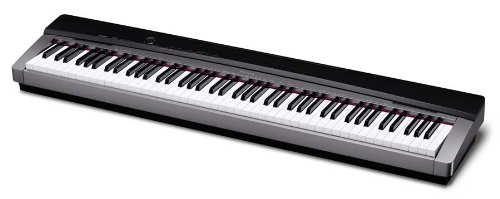Guitar Scales! I know I've harped about how important modes are to being able to expand your musical horizons. It's time to focus on the more basic principle: if you learn how to play guitar scales well, playing melodies will follow nicely, allowing you to play that kick-ass guitar solo you've been hearing in your head but can't bring out of your axe yet. If you know chords, you'll be able to add an appropriate chord progression to your melody as well. If you don't know chords, learn them! Even if you only learn a couple of power chords, you'll be able to add a progression to your tune.
My point is that you need to practice guitar scales, even when you're good at your instrument. The best musicians do this regularly, on any instrument. They all play some incarnation of scalar exercises. In piano, they're usually called etudes. Playing etudes and scales will help build the muscle memory in your fingers, and also strengthen them so that the more you play scales, the more natural it feels.
I've included the A Aeolian (minor) guitar scale here, which is is fairly popular since you can play an A chord with an open string. Plus, it goes along well with a piano player who isn't too well-versed with the black keys. I'm only including it as a reference, not as a teaching guide. When playing both octaves, remember to adjust your finger position from fret 5 to fret 7 for the second octave.
Find some rhythmic patterns to play the scale to, and you'll find that it's not that hard to find a unique melodic groove.
I like playing a full scale in 5/4 time, which is an odd time signature, but it's fun. I play the first note of each octave on the previous half-beat. Let me show you what I mean...
Counter above, notes below:
4 - 5 - | 1 - 2 - 3 - 4 - 5 - | 1 - 2 - 3 - 4 - 5 - | 1 - 2 - 3 - 4 -
------A-----B-C-D-E-F-G-A2--A2----B2C2D2E2F2G2A3--A-----B-C-D-E-F-G-A2
I need to learn how to format spaces on EzineArticles.com. Anyway, this is good practice for finding your finger positions to repeat that over and over as an exercise. I've put finger positions that should be used up on top of this tab to help out. Remember to adjust your 1st finger from 5th fret to 7th fret on the second octave! Life will be easier.
It would be good practice to learn legato technique here so that you don't have to pick every string. It sounds much smoother to hammer on (press your finger quickly and firmly without picking the string) when going up the guitar scale and pull off (pluck the string with your finger as you release it) when going back down the guitar scale. It works better when your pickups are sensitive and your amp has a good level of distortion. If you have an acoustic guitar, you can still practice these techniques, but the sound won't be as noticeable to you. Legato just means that the notes are connected--there is no break between one to the next. Pluck the first note on a string, then hammer the rest. Pluck the first note of the next string, hammer the rest, etc. Try to make sure your plucking is no more harsh than your hammers or pulls. It is a technique that takes time and practice, but it sounds good when done right.
(/) Slide Up () Slide Down (h) Hammer On (p) Pull Off (b) Bend (r) Release (v) Vibrato
....1..3..4..1..3..4..1..3...1...3..4...1..3..4...2..4
E|------------------------------------------------------
B|------------------------------------------------8--10-
G|--------------------------------------7--9--10--------
D|--------------------5--7v--7v--9--10------------------
A|-----------5--7--8------------------------------------
E|--5--7--8---------------------------------------------
Created with guitartabcreator.com online.
As a bonus, here's an etude that you can play on just two strings and in one finger position that will help strengthen your little finger so you can really shred later on. It's based on the A harmonic minor scale.
(/) Slide Up () Slide Down (h) Hammer On (p) Pull Off (b) Bend (r) Release (v) Vibrato
E|-------------------------------------------------------------------------|---------
B|-------------------------------------------------------------------------|---------
G|-------------------------------------------------------------------------|---------
D|-------------------------------------------------------------------------|---------
A|--------------------5--------5--7-----5--7--8--5--7--5-----7--5----------|---------
E|--5--7--8--5--7--8-----7--8--------8--------------------8--------8--7--4/|--5v--v--
Created with guitartabcreator.com online.
Please let me know if you have any questions, as this might not be perfectly clear to some of you newer guitarists.
Until next time, cheers!
 | Price : Too low to display
| Price : Too low to display







